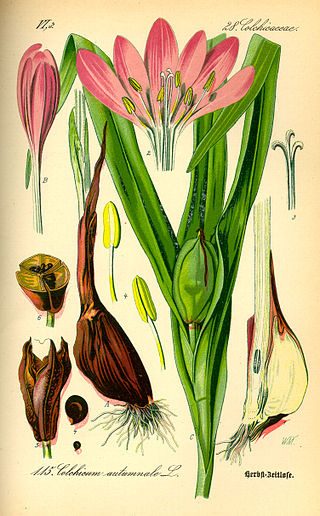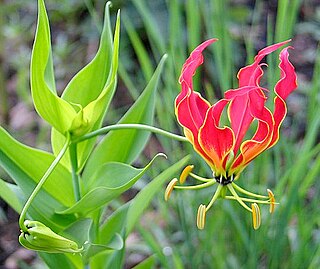
Colchicum is a genus of perennial flowering plants containing around 160 species which grow from bulb-like corms. It is a member of the botanical family Colchicaceae, and is native to West Asia, Europe, parts of the Mediterranean coast, down the East African coast to South Africa and the Western Cape. In this genus, the ovary of the flower is underground. As a consequence, the styles are extremely long in proportion, often more than 10 cm (4 in). All species in the genus are toxic.

Asphodelus ramosus, the branched asphodel, is a perennial herbaceous plant in the order Asparagales. Similar in appearance to Asphodelus albus and particularly Asphodelus cerasiferus and Asphodelus aestivus, it may be distinguished by its highly branched stem and smaller fruits. There has been a lot of confusion over the nomenclature and taxonomy of the species, owing to its similarity to Asphodelus aestivus.

Gloriosa is a genus of 12 species in the plant family Colchicaceae, and includes the formerly recognised genus Littonia. They are native in tropical and southern Africa to Asia, and naturalised in Australia and the Pacific as well as being widely cultivated. The most common English names are flame lily, fire lily, gloriosa lily, glory lily, superb lily, climbing lily, and creeping lily.

Colchicaceae is a family of flowering plants that includes 15 genera with a total of about 285 known species according to Christenhusz and Byng in 2016.

Colchicum autumnale, commonly known as autumn crocus, meadow saffron, naked boys or naked ladies, is a toxic autumn-blooming flowering plant that resembles the true crocuses, but is a member of the plant family Colchicaceae, unlike the true crocuses, which belong to the family Iridaceae. It is called "naked boys/ladies" because the flowers emerge from the ground long before the leaves appear. Despite the vernacular name of "meadow saffron", this plant is not the source of saffron, which is obtained from the saffron crocus, Crocus sativus – and that plant, too, is sometimes called "autumn crocus".

Carl Sigismund Kunth was a German botanist. He was also known as Karl Sigismund Kunth or anglicized as Charles Sigismund Kunth. He was one of the early systematic botanists who focused on studying the plants of the Americas. Kunth's notable contributions include the publication of Nova genera et species plantarum quas in peregrinatione ad plagam aequinoctialem orbis novi collegerunt Bonpland et Humboldt. This work spanned seven volumes and was published between 1815 and 1825.

Phaedranassa is a genus of South American and Central American plants in Amaryllis family, subfamily Amaryllidoideae.

Adolphia is a genus of shrubs in the buckthorn family containing only two species.

Sandersonia is a monotypic genus of rhizomatous plant, belonging to the family Colchicaceae, the single species Sandersonia aurantiaca being native to South Africa and Eswatini (Swaziland). Common names for S. aurantiaca include Christmas bells, golden lily of the valley, Chinese lantern lily and Chinese lantern bulb. S. aurantiaca is a perennial plant of trailing growth that can reach 30 inches in height. The flowers are yellow or orange.

Corynanthe johimbe, synonym Pausinystalia johimbe, common name yohimbe, is a plant species in the family Rubiaceae native to western and central Africa. Extracts from yohimbe have been used in traditional medicine in West Africa as an aphrodisiac, called in some languages burantashi, and have been marketed in developed countries as dietary supplements.

Wurmbea is a genus of perennial herbs in the family Colchicaceae, native to Africa and Australia. There are about 50 species, with about half endemic to each continent.
John Dransfield is former head of palm research at the Royal Botanic Gardens, Kew, United Kingdom.

Baeometra is a genus in the family Colchicaceae containing a single species, Baeometra uniflora. It is native to South Africa, where it is commonly called beetle lily due to the dark markings on the tepals.

Gloriosa superba is a species of flowering plant in the family Colchicaceae. Common names include flame lily, climbing lily, creeping lily, glory lily, gloriosa lily, tiger claw, and fire lily.

Zuloagaea is a monotypic genus of the central American plants in the grass family. It only contains one known species, Zuloagaea bulbosa(Kunth) Bess It was formerly known as Panicum bulbosumKunth

Colchicum stevenii, or Steven's meadow saffron, is a species of flowering plant in the family Colchicaceae. Hebrew: סתוונית היורה, Arabic: سَراجُ الغولة, سُورَنْجان
Nectouxia is a monotypic genus of flowering plants belonging to the family Solanaceae. The only species is Nectouxia formosa. It is in the Solanoideae subfamily and in Subtribe Salpichroinae, which is a subtribe of Physaleae.

Zanthoxyloideae is a subfamily of the family Rutaceae.

Gaya is a genus of flowering plants belonging to the family Malvaceae. It has been classed in the Malvoideae subfamily and the Malveae tribe.

















